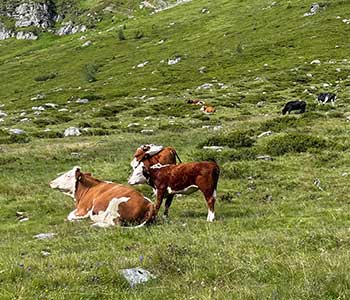
Facts, figures and data on the dairy industry
The illustration is deceptive. Our milk and dairy products have long since ceased to come from happy cows on lush alpine meadows. Even those from organic farming in the supermarkets come from highly industrialised production - with somewhat better conditions for the animals. Happy cows, calves and bulls have become rare. You can still meet them on our alpine pastures and on Demeter-certified farms. And on the green island of Ireland, the world should still be halfway okay for cows. If they didn't burp so much ...
August 2023
While wandering in the beautiful Schladming Alps, where this photograph comes from, we passed herds of cows every now and then. In the midst of them were calves and here and there a bull. At the same time, we read in the newspapers that 200,000 cattle are to be culled in Ireland for climate reasons. A cause to look at the dairy industry between idyll and horror.
According to the Süddeutscher Zeitung, more than 7 million cattle live in the Republic of Ireland - with a population of around 5 million. An absurd number. In comparison, 1.9 million cattle live in Austria with 9.1 million inhabitants. Not a few either. According to Statista, we have a domestic milk self-sufficiency rate of 177 percent and have to export. The Irish self-sufficiency rate could not be researched, but must be correspondingly exorbitant. In any case, 40 per cent of Ireland's total exports are dairy products. For butter and beef, the island is the leading EU exporter to third countries; for beef, it has a self-sufficiency rate of 543 per cent, Austria of 147.
Irish milk production figures. The 1.45 million Irish dairy cows are doing comparatively well. They spend around 310 Tage on pasture, are therefore relatively less sick and are raised with correspondingly less medication. Farmers also benefit enormously from this, as grazing is much cheaper than intensive housing in stables. By feeding on the fresh and additionally free grass, the milk is also richer in vitamins and contains more unsaturated fatty acids. Irish cows also have to perform less. Compared to the pitiful turbo cows with giant udders that have to produce over 10,000 litres of milk a year and 27.4 a day, Irish dairy cows do 5,000 and 13.7 litres. However, as recently as the 1970s, the average milk yield of a European cow was 3,000 and 8.2 litres. But still, thumbs up for Irish cattle farming. Thumbs down for the quantity of cows.
This is because the cows belch and emit climate-damaging gases with their manure and dung, polluting the groundwater, rivers and lakes with nitrate, nitrogen and phosphates. A single cow can produce 400 to 700 litres of methane per day, depending on the feed and breed. This greenhouse gas is twenty times worse for the climate than CO2. Agriculture is one of the main contributors to greenhouse gas-driven climate change, with livestock being one of the largest emitters, accounting for between 14 and 20 per cent, depending on the country. In Ireland, agricultural emissions accounted for 37.5 per cent in 2021, the majority of which was produced by cattle and sheep during digestion. Therefore, according to an options paper of the Irish Department of Agriculture, emissions from agriculture are to be reduced by a quarter by 2030. This is to be achieved by ng other things culling 65,000 cattle annually over the next three years and 200,000 cattle in total. Why fewer animals are not simply inseminated is not clear from the paper. With 7 million animals, 200,000 are only a drop in the ocean anyway.
How do things look in domestic milk production? According to the responsible ministry, the Austrian dairy industry accounts for about 18 percent of agricultural production. 89 percent of the total production is delivered to dairies. Of this, the entire production is GMO-free, 19 percent is organic milk and 15 percent is hay-milk.
In cattle farming, a dairy cow is usually inseminated annually. The calf is removed from the mother within a few days, sometimes within a few hours of its birth, and placed in individual stalls or with other calves. Mother and calf often call out to each other and suffer for days. The calf is fed so-called "milk replacer", a milk substitute intended to stimulate growth and later milk production. By the way, calves in meat production are fed anaemically so that the meat remains as light as possible. This is still considered a "mark of quality" in our supermarkets. Of course, the animals are also dehorned, a painful process in which the horn systems are sclerosed by means of burning rods. In conventional farming, this may happen without sedation.
Future dairy cows are inseminated for the first time at the age of one and a half years. After nine months of pregnancy and calving, the cows are milked for the first time, and the procedure is repeated annually - often supported by hormone administration. 2.5 months after calving, insemination takes place again. The average age of an Austrian dairy cow is 6.3 years, she is made pregnant three times for milk production.
Austrian law distinguishes between
1. conventional dairy cow husbandry
Cows may be kept in closed stalls all year round, but must have freedom of movement for 90 days a year. Tethering, where cows are tethered to fixed places, may last up to eight hours during the day (as of 2021). Feeding is often a mixture of basic fodder (hay, silage) and concentrated feed. The use of growth promoters and other additives in feeding is permitted. Preventive medicines are provided and are common practice. Full slatted floor is also allowed.
2. organic dairy cow husbandry
Bio Austria is stricter than the EU organic label. The cows have more space and freedom of movement than in conventional farming. They must have access to pasture 120 days a year, outdoor exercise is an important aspect. Tethering is not allowed in organic farming. The stable must meet the animals' needs, for example by providing cubicles or deep litter. Feeding is predominantly organic, including pasture grass, hay and silage. Concentrated feed may make up to 15 percent. Animals must be treated individually in case of illness, no preventive medication is allowed. Animals may be dehorned, but must be sedated. Calves must be fed on mother's milk or organic milk for three months, but may be separated from their mother immediately after birth.
In addition there is
3. biodynamic dairy farming (Demeter)
Biodynamic agriculture is not anchored in law. Demeter is an association whose standards are controlled by independent bodies. These standards go far beyond the organic ones. For example, cattle may not be dehorned. The calves stay with their mothers until they are no longer dependent on milk. Feeding is exclusively organic and without concentrated feed. Importance is attached to cattle breeds suited to the location and to the preservation of old breeds.
Eating and drinking is always a political choice; good nutrition has become complicated. Education is needed, so here is my small and only roughly outlined contribution. Perhaps it will bring about a moment of reflection when we reach for a milk carton or yoghurt on the shelf - and make a choice for the organic product after all, or limit our consumption altogether.




